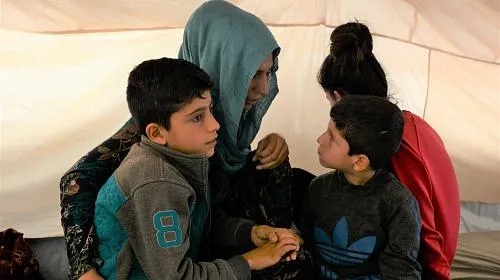AMMAN (November 6, 2019) – As temperatures plummet across the Middle East, CARE warns that tens of thousands of people, including women and children, in north-east Syria are at risk of facing harsh weather conditions without needed protection. Over 100,000 people are still displaced, out of whom more than 15,000 are living in collective shelters, according to the United Nations, with few possessions or clothing, making them more vulnerable as the winter approaches.
“Many of the places where people are sheltering are old schools, unfit for hosting displaced families. Doors and windows are broken and there is nothing to shield people from inclement weather. The poorest, who are going to collective shelters, only have the clothes they are wearing and, sometimes, a small amount of money that is only enough to buy them food for a few days,” says Aleksandar Milutinovic, CARE’s Country Director in Syria.
The influx of displaced populations into Hassakeh city has resulted in a shortage of available places for rent. The ones left are overpriced, which most cannot afford. Many families have stayed with relatives, but report that after a while, they have no other choice but to go to collective shelters because of the expense and loss of privacy the hosting families have to bear.
“We are distributing winter clothes for children, mattresses, blankets, floor mats and plastic sheeting that people use to block the cold wind, but these do not come close to covering the huge needs. Some of the classrooms have been deserted without maintenance since the war started, and are in need of rehabilitation. We have had rainfall over the past week and with open doors, broken windows and no carpets or blankets in collective shelters, these buildings are cold,” says Baran*, an aid worker for CARE in northern Syria.
The lack of maintenance has also meant that collective shelters do not have functioning water and sanitation facilities, leading people to have to leave their shelters in search of these facilities. They sometimes go to mosques, while other times, people have opened their homes for the displaced to use the toilet. This practice poses a safety risk to women and girls, who sometimes have to walk distances by themselves at night.
While most winter clothes distributions by humanitarian actors have thus far focused on children as a priority, women and men are also in need of warm clothes, having quickly fled their houses in light clothing when the military operations began in early October.
“There is a shortage in fuel in the area and kerosene heaters, which are what most families use in the winter because of their affordability, are now unavailable. People are unable to pay for fuel to keep them and their families warm and there are many women and small children among the displaced. There is an urgent need to provide winter clothes, heaters, fuel, and cash distributions for the winter,” Baran adds.
*Names have been changed to protect identities.
About CARE’s response in Syria
CARE is assisting vulnerable and displaced people in northeast Syria by providing clean water, sanitation and hygiene promotion. CARE is carrying out much-needed distributions of hygiene kits and winter clothes and providing psychosocial support, including psychological first aid to those immediately affected by the violence. CARE plans to reach 20,000 people in northeast Syria with life-saving and emergency assistance by the end of October. CARE has been providing aid in Syria since 2014, and has reached more than 4.5 million people so far. Our work is focused on food security, livelihoods, women’s economic empowerment, shelter, water and sanitation, maternal and reproductive health support, and psychosocial support for people in crisis.
About CARE:
Founded in 1945, CARE is a leading humanitarian organization fighting global poverty. CARE has more than seven decades of experience helping people prepare for disasters, providing lifesaving assistance when a crisis hits, and helping communities recover after the emergency has passed. CARE places special focus on women and children who are often disproportionately affected by disasters. CARE works in more than 90 countries, reaching over 50 million people through over 950 poverty-fighting development and humanitarian aid programs.
Media Contacts:
Vanessa Parra, vanessa.parra@care.org, +1 917-525-0590 (NYC)
Mahmoud Shabeeb, mshabeeb@care.org, +962 79 146 39 03 (Amman, Jordan)

